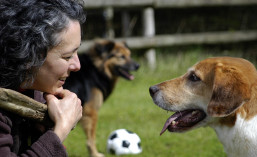I was pulling weeds in front of my house recently when a neighbor stopped to chat. He asked why I was wasting energy gardening “the hard way.” Mind you, this man’s yard is immaculate. Putting greens look shabby compared to his velvet emerald lawn.
When I first moved to my neighborhood, I coveted this perfection. You might say I was “green” with envy. Soon though, I realized that his tidy splendor came at a cost. Every week, a truck absurdly emblazoned with a killer whale pulled up to his house. A white-suited man got out and unrolled a hose used to spray buckets of chemicals – pesticides and herbicides – on the grass and shrubs. On the surface, it looked immaculate, but those chemicals destroyed the microorganisms and insects that support long-term viability of the soil. The result: an illusion of a healthy garden.
I’m committed to the principles of organic gardening. Admittedly, my yard is less than perfect. It’s a bit unruly, but it’s also full of life. Worms and ladybugs, bees and butterflies abound. I spend time tilling the soil, enriching it with compost. I choose plants appropriate for the soil and light conditions. I welcome diversity and am often pleasantly surprised by the volunteers that sprout in the beds. The eventual result: a truly vibrant garden.
I see many similarities between gardening and dog training. Both attempt to direct the growth and behavior of living organisms. Both try to exert some control over messy Mother Nature. And just as the techniques you use to nurture your garden affect the overall well-being of the plants and animals there, the techniques you use to train your dog can have a dramatic and lasting effect on his overall health and well-being.
I’m committed to using positive reinforcement techniques (such as clicker training) with the animals I live with and work with. Like organic gardening, positive dog-training methods have gained legions of faithful adherents in the past decade, but they aren’t yet customary in many places.
To those who have achieved success using “traditional” methods, (e.g., spraying toxic pesticides on their apple trees or using a shock collar on their hunting hound), these newer philosophies may seem labor-intensive, extreme and unnecessary. Why bother doing it “the hard way,” they wonder?
We dog-friendly trainers know why. From the start, we devote time developing a fertile, rich rapport with our animals. We build trust, the tilth of relationships. We commit to the dictum, “First, do no harm.” We acknowledge the potential for irrevocable fall-out resulting from indiscriminate and widespread use of aversives, the all-purpose “defecticide” in a trainer’s toolbox. We value diversity and are grateful for the myriad behaviors our animals offer us, because we realize that behavioral variability is the foundation of efficient training. When unwanted, weedy behaviors crop up, we nurture desirable substitutes as replacements. And we know that just as weeds take advantage of sterile lawns, undesirable habits (e.g., destructiveness or whining) require a behavioral void to take root.
And always, we remember that no living thing is perfect. Whether we aspire to create a flawless perennial bed or a faultless pug, the chaos of real life always intervenes. The best we can do is invest time and energy from the beginning, sowing seeds of cooperation and nurturing the natural strengths of each unique being in our care. All that diligent effort will lay the groundwork for a later explosion of accelerated growth. The garden will burst forth with color and abundance; the animal will learn new tasks with incredible speed and ease. This peak performance will require maintenance, of course, but the bulk of our job was completed with “the hard work” of the early days. In time, we will have earned the right to sit back in our chaise longue, soaking up compliments, content in the knowledge that no creatures were harmed in the making of our masterpiece.
